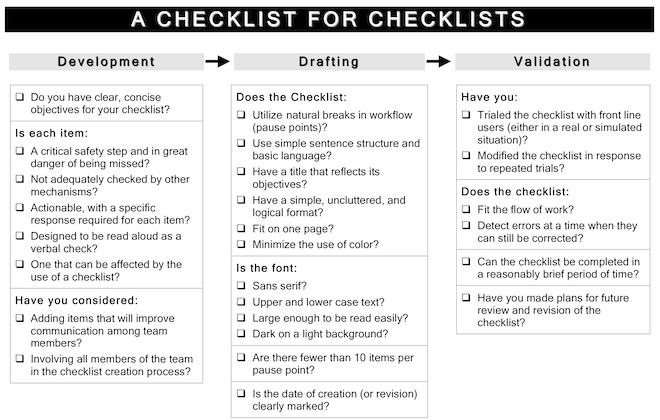Checklists for everyone
/Avoidable failures are common and persistent, not to mention demoralizing and frustrating, across many fields — from medicine to finance, business to government. And the reason is increasingly evident: the volume and complexity of what we know has exceeded our individual ability to deliver its benefits correctly, safely, or reliably. Knowledge has both saved and burdened us.

The creation of the now heralded 19-item surgical checklist found its roots in three places — the aviation industry, restaurant kitchens, and building construction:
Thinking about averting plane crashes in 1935, or stopping infections in central lines in 2003, or rescuing drowning victims today, I realized that the key problem in each instance was essentially a simple one, despite the number of contributing factors. One needed only to focus attention on the rudder and elevator controls in the first case, to maintain sterility in the second, and to be prepared for cardiac bypass in the third. All were amenable, as a result, to what engineers call "forcing functions": relatively straightforward solutions that force the necessary behavior — solutions like checklists.
What is amazing is that it took more than two years, and a global project sponsored by the World Health Organization, to devise such a seemingly simple piece of paper. But what a change it has had. Major complications fell by 36%, and deaths fells by 47%. Would you adopt a technology that had a 36% improvement in outcomes, or a 36% reduction in complications? Most would without batting an eye.
But the checklist paradigm is not without skeptics. There is resistance to the introduction of the checklist because it threatens our autonomy as professionals, our ego and intelligence that we have trained hard to attain. An individual must surrender being the virtuoso. It enables teamwork and communication, which engages subordinates and empowers them at crucial points in the activity. The secret is that a checklist, done right, is more than just tick marks on a piece of paper — it is a vehicle for delivering behavioural change.
I can imagine huge potential for checklists in the problems we face in petroleum geoscience. But what would such checklists look like? Do you know of any in use today?
<img src="https://docs.google.com/drawings/pub?id=1obXW2658bqCNt6OpOzSU_vhfEdDKPHH467cqIDdpCoE&w=480&h=360">










 Except where noted, this content is licensed
Except where noted, this content is licensed